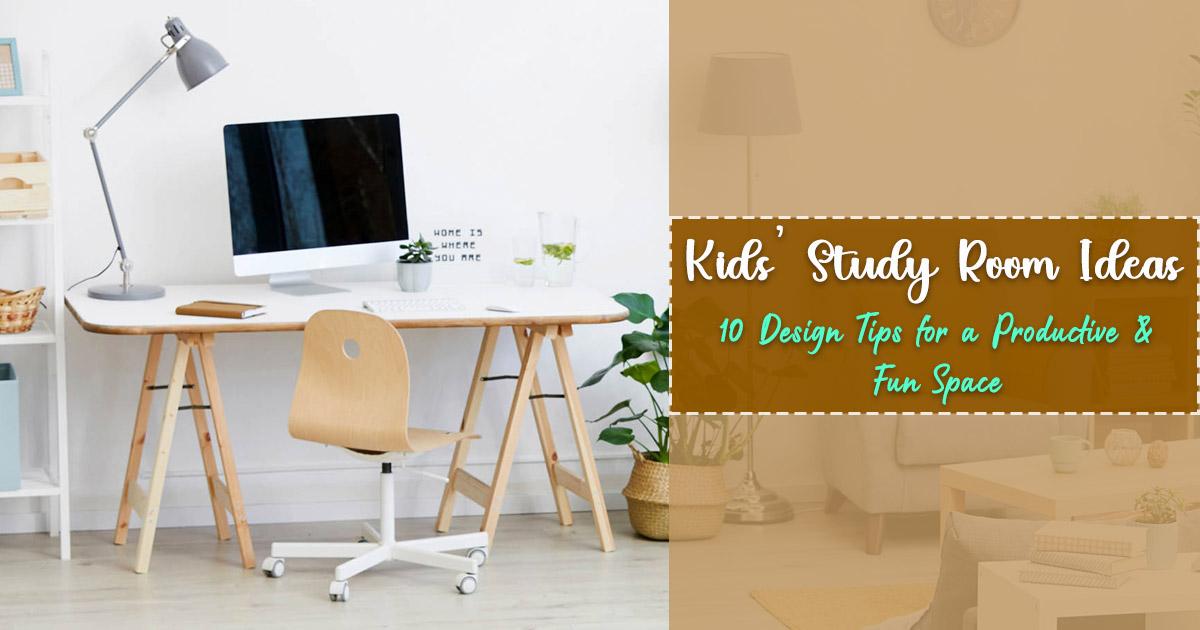Kids’ Study Room Ideas: 10 Design Tips for a Productive & Fun Space

Every parent wants their kids to do well in school because it can lead to many opportunities in the future. Supporting them means more than just making sure they do their homework; it’s about helping them build good study habits both at school and at home. Teachers guide them during school hours, but at home, parents need to create a good environment for studying.
Creating a special study space at home is one of the best ways to help kids focus on their work. Studies show that having a dedicated area for studying can greatly improve a child’s ability to concentrate, stay organized, and develop a routine for better learning.
Benefits of Having a Dedicated Study Space for Kids at Home
Having a special study space for kids at home brings many long-term benefits that can help them do better in school and feel good overall:
- Improved Focus and Productivity: A separate study area helps kids concentrate by cutting down on distractions, making study time more efficient and productive.
- Better Organization: A designated space encourages kids to keep their things tidy, making it easier to find what they need and stay organized.
- Consistent Routine: Studying in the same place every day helps kids get into a routine, which makes managing time easier.
- Personal Responsibility and Independence: Taking care of their own study space teaches kids responsibility and independence.
- Reduced Stress: Knowing they have a specific place to study can reduce anxiety and create a calm atmosphere.
- Promotes Good Posture: Ergonomic furniture helps kids sit properly, preventing discomfort during long study sessions.
- Supports Academic Success: Regularly using a dedicated study space can lead to better study habits and improved grades.
- Encourages Creativity: Letting kids personalize their study area can make them feel more invested and inspired.
- Better Sleep Patterns: Separating work areas from relaxation spaces helps kids associate their bedroom with sleep, which improves sleep quality.
How to Create a Kids’ Study Area
Creating a great study space for your kids at home involves adding some key elements. Here are ten things you should include:
1. Quiet Environment
A quiet spot in the house helps kids focus better by reducing noise distractions. Pick a place away from busy areas and loud noises. If you don’t have a quiet spot, use noise-cancelling headphones or white noise machines to block out sounds.
2. Appropriate Desk
A good desk is essential for a productive study space. It should be sturdy and at the right height for your child to sit comfortably. Measure your child’s height to find the perfect desk size, and look for one with enough space for books, laptops, and writing materials. Adjustable desks that grow with your child are a great option.

3. Comfortable Chair
An ergonomic chair supports proper posture, making it more comfortable for kids during long study sessions. Choose a chair with adjustable height and good back support. Let your child try the chair before buying it to ensure it’s comfortable. Adding a cushion can provide extra comfort if needed.
4. Good Lighting
Proper lighting is crucial to avoid eye strain and create a good study environment. Natural light is best, so place the study area near a window. Add a desk lamp with adjustable brightness to control light levels, ensuring that there are no shadows on the workspace.
5. Functional Layout
The way you arrange the study area can help minimize distractions. Place the desk facing a wall instead of a window or busy area to keep visual distractions at bay. Keep the layout simple and uncluttered, allowing enough room for your child to move comfortably.
6. Storage Solutions
Organized study materials make it easier for kids to find what they need and reduce clutter. Add shelves, drawers, and organizers to the study space. Use drawer dividers for small items like pens and clips, and install wall-mounted shelves to save floor space.
7. Supplies Within Reach
Keep essential supplies like pencils, paper, calculators, and reference books within easy reach to avoid interruptions. Use desk organizers, containers, and caddies to store supplies neatly. Label containers to make it easy to find items and encourage your child to put things back after use.
8. Technology Integration
Make sure necessary technology, like a computer or tablet, is set up properly and has easy access to power outlets. Use cable organizers to manage cords and keep the workspace tidy. Consider installing parental control software to monitor screen time.
9. Calendar and Clock
A calendar helps track assignments and deadlines, while a clock helps with time management. Hang a calendar near the study area and mark important dates together with your child. Place a clock where it’s easily visible, and teach your child to allocate specific times for different tasks and breaks.
10. Personal Touches
Personalizing the study space can make kids feel more invested and inspired. Encourage your child to choose posters, artwork, or motivational quotes they like. They can also add a bulletin board for pinning important reminders and inspirational items.
A Study Space Kids Actually Want to Use
Creating a good study space is just the start. To make sure your child actually wants to use it, give them some freedom and control over how they study. Let them decorate their space, choose their study times, and take breaks when needed. When kids feel like the space is truly theirs, they’re more likely to enjoy using it and develop good study habits.
This sense of ownership not only makes studying more enjoyable but also helps them learn important skills like managing their time and being responsible. By mixing structure with freedom, you can create a study area that your child will love and thrive in.

